Tucked away in Queretaro’s historical center, this museum tells the dramatic story of Mexico’s fight to reclaim its republic. The building itself, a former Capuchin convent, plays an important role in that history. It is the site where Mexico’s last emperor, Maximilian I, an Austrian archduke installed by France’s Napoleon III, was imprisoned before he was taken for execution.
The building dates back to the early 18th century, when it housed an order of Capuchin monks. They were forcibly evicted under the state’s secularizing Reform Laws in 1861. Since then, the building has held a variety of uses, including as a military barracks, a prison, an orphanage, two schools, and now a historical museum.
The quiet cloister is a surprisingly central witness to the political transformation of 1867, in which France and Habsburg Austria attempted to establish a monarchy over Mexico and triggered a civil war with Benito Juarez’s republican forces who besieged the walled city of Queretaro. The Imperialists were eventually betrayed by a Colonel who accepted a Republican bribe to open the gates to the city in the dark of night, and Emperor Maximilian I and his generals were imprisoned in this Capuchin convent.
This fascinating history of hubris and deceit is brought to life with historical artefacts including detailed maps of the city’s battleground, preserved weapons, and historical paintings which detail the fall of Mexico’s short-lived empire. An exact replica of the prison room where Emperor Maximilian spent his final days, more like a hotel room than a cell, can be found on the top floor. His original room situated next to the recreation has been converted into an exhibition space.
It’s a fitting place to memorialize the collapse of an imperial fantasy and stands a 15-minute walk from the site where Emperor Maximilian I was executed by firing squad.
